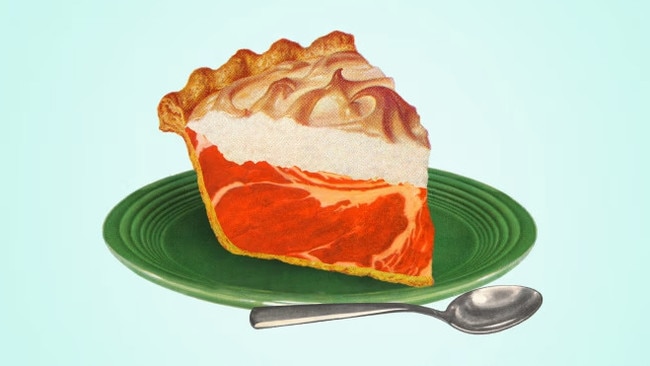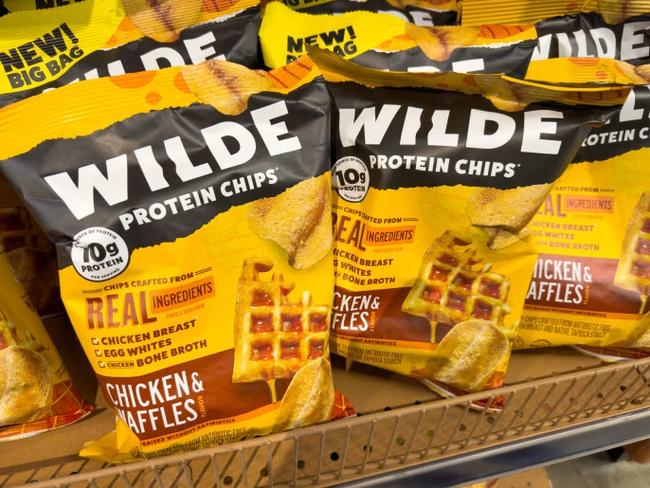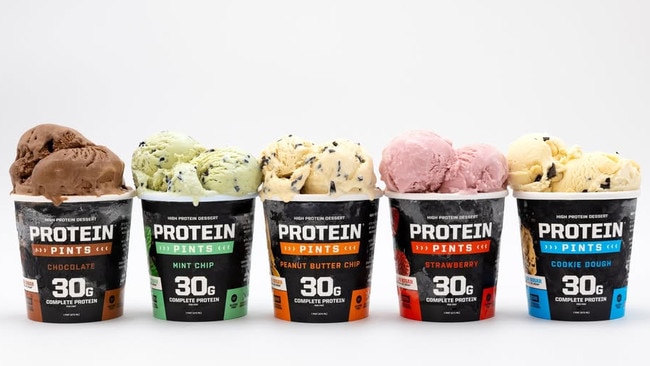Americans are obsessed with protein and it’s driving nutrition experts nuts
Food companies pack the nutrient into candy, coffee and even water. ‘How about a chicken breast, people?’

Morgan Gates starts off his day eating six eggs. Later he will down a smoothie made with Greek yoghurt, protein powder and berries. For dinner, it’s a pound (450g) of red meat.
The 28-year-old sales representative is big on protein. “I found that if I prioritised protein and half-assed the rest of everything else, it gave me the body I wanted,” he said.
Gates’s two dogs follow a similar diet. The $US367 billion ($575bn) US food industry is on board, too, pushing protein beyond cereals and snack bars and into new realms such as coffee, sweets and water.
Snack maker Wilde created a protein chip from chicken breasts, egg whites and bone broth. Protein Pints made its national debut this spring, offering cookie dough and mint chip-flavoured ice cream tubs with 30 grams of protein each. Ontario-based Protein Candy rolled out brightly coloured confections promising 14 grams of protein a bag — the equivalent of eating a half cup of cottage cheese — calling it for a while “candy that works as hard as you do”.

To wash it down, there are protein-infused beverages made from whey or peas and collagen — a staple ingredient in wrinkle creams and lip injections sourced from animal bones, skin or cartilage.
Feisty soda boasts 10 grams a can, making it more protein-dense than an egg, according to the brand. UK-based Vieve, a purveyor of fruit-flavoured protein water, says it took the company two years to figure out how to slip 20 grams of protein into the drink. Founder Rafael Rozenson said the idea was born from an intense dislike of other options on the market, especially for gym-goers.

“Some people don’t need our product,” Rozenson said. “If you’re sitting on the sofa it might not be interesting for you.”
Other food executives have taken note of Americans’ mission to jam more of the star nutrient into their diets. Food makers in 2024 introduced 97 new products with “protein” in the brand name, more than double the year prior, according to market-research firm Mintel. In the year to February 22, the fastest-growing grocery items were those with the most protein per serving — 25 grams or more, according to NielsenIQ data.
People such as Daniel Imberman, a software engineer in California, are eating it up. The self-professed protein connoisseur says his focus is discovering “protein crap”, healthy options that taste like junk food.
A fan of protein chips and protein ice cream, he’s also partial to Barebells — 2-ounce (57g) protein bars that come in flavours like marshmallow peanut road, birthday cake and salty peanut. “They’re my guilty pleasure,” he said.

Imberman wolfs one down five times a week. “People love to get the blessing to do the thing they know they’re not supposed to do,” he said.
But the processed protein buffet is driving many nutrition experts and personal trainers nuts.
Constance Contursi, a personal trainer in suburban Chicago, says many of her clients mistake junk food as healthy because it contains added protein. “How about a chicken breast, people?” she said. “How about an egg?”
America’s long-running love affair with protein has intensified as weight-loss drugs have taken off, with many users trying to boost protein intake to offset lost muscle mass while they shed pounds. Meanwhile, a social-media-fuelled focus on health and fitness is crowding more protein powders into kitchen cupboards, moving the chalky substances from a gym-rat mainstay to the mainstream.
Tricked out algorithms on TikTok are pushing everything from the carnivore diet to protein Diet Coke, a dubious combination of soda and a protein shake. Protein shakes themselves recently starred in the third season of HBO’s hit show, The White Lotus, when Patrick Schwarzenegger’s addiction to the drinks became a pivotal plot point.

Most Americans aren’t hurting for protein. US nutrition recommendations call for healthy adults to consume 0.8 grams per kilogram of body weight a day. For a 68kg person, that works out to about 54 grams — found in a half-pound chicken breast, or two eggs with a cup of plain, non-fat Greek yoghurt plus a cup of nuts.
Even with protein, you can have too much of a good thing, said Bettina Mittendorfer, professor of medicine, nutrition and exercise physiology at the University of Missouri School of Medicine. Mittendorfer led a study that found that overload of certain amino acids, found in protein, can lead to cardiovascular disease. For the study, her team shoehorned extra protein into the pasta and sauces they cooked for participants. “It’s like eating sand on the beach,” she said.
Mittendorfer said stuffing protein into waffles and soup has more to do with marketing than anything else. The nutrient Americans do need more of is fibre, she said. But that’s a harder sell. “Would you rather have muscle strength and vitality, or prunes and Metamucil?”
Ballerina Farm, the ranch and viral social-media account run by Hannah Neeleman and her husband, Daniel Neeleman, recently launched a protein powder made with bovine colostrum, the milk-like fluid a mother cow produces in the first few days after giving birth.
Ms Neeleman is a Juilliard-trained ballerina who has captured online fame with photos and videos depicting her lifestyle in rural Utah as a mother of eight. Mr Neeleman is a weightlifter and bona fide protein devotee, starting his day with bone broth and later consuming protein powder, creatine and amino acids.
But the protein powder’s real star is Dandy, a beloved family milk cow.
Ms Neeleman said the couple began drinking Dandy’s leftover colostrum — plain and in smoothies — each time she gave birth to a calf.
“You have this concentrated dose of God-given elixir,” said Mr Neeleman. Soon, the idea for Farmer Protein was born.
Bovine colostrum as a wellness trend has its detractors, including animal rights groups that argue it, like milk, is for mother cows to feed their babies. The Neelemans said they source colostrum from farms that make sure to give calves the colostrum they need, and only use the excess for protein powder.
It’s now their best-selling product, surpassing wooden measuring spoons, beef jerky and sourdough starter (pairs well with the farm’s high-protein flour).
The Wall Street Journal




To join the conversation, please log in. Don't have an account? Register
Join the conversation, you are commenting as Logout